https://www.heise.de/hintergrund/Makey-Lab-Der-leichte-IoT-Einstieg-fuer-junge-Maker-10498312.html
Archiv des Autors: Sebastian Trella
Kosmos Bionic Robotic Arm im Test – Bionischer Roboterarm als Experimentier-Set
Der Kosmos Bionic Robotic Arm ist ein Experimentierbaukasten, der Elemente aus Bionik und Modellbau kombiniert. Das Set richtet sich an junge technikinteressierte Menschen ab etwa zehn Jahren und verbindet Lernerfahrung mit Bastelspaß.
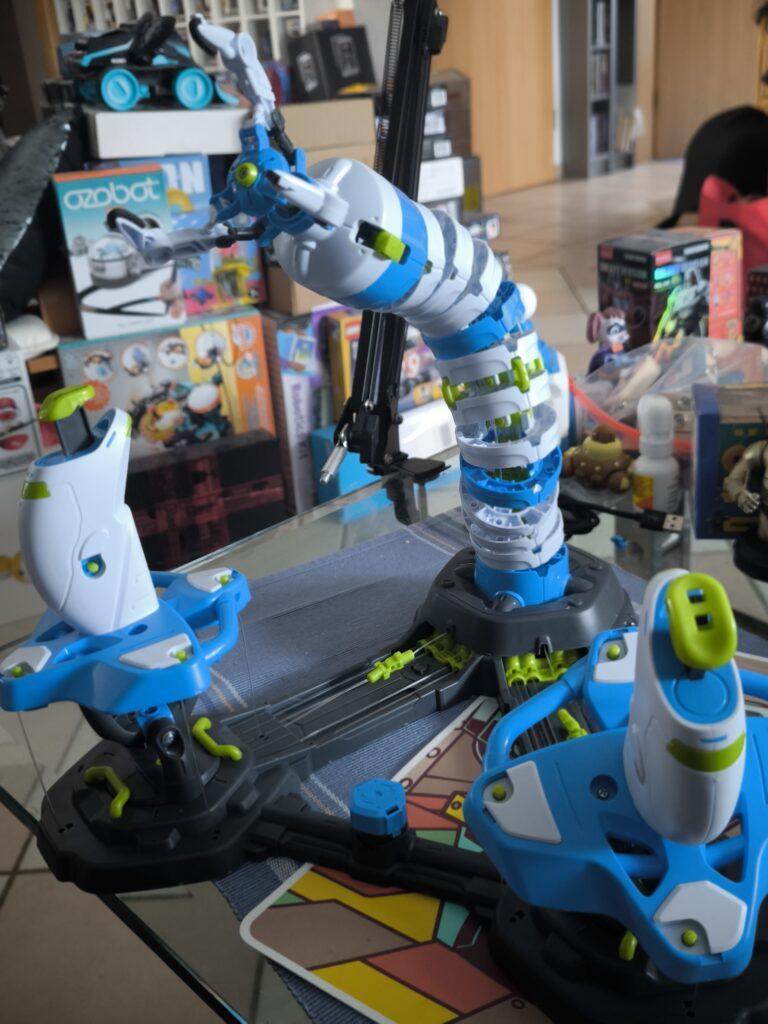
Konzept und Funktionsweise
Im Mittelpunkt steht ein mechanischer Roboterarm, dessen Bewegungsprinzip am echten Elefantenrüssel orientiert ist. Statt Elektromotoren kommt ein ausgeklügeltes System aus Nylonfäden zum Einsatz. Diese wirken im Modell wie künstliche Muskeln und Sehnen. So gelingt es, den Arm in viele Richtungen zu bewegen; die Bewegungen erscheinen sehr flexibel und erinnern an Science-Fiction-Konstruktionen.
Gesteuert wird der Arm über zwei Joysticks. Der eine ist für den oberen, der andere für den unteren Bereich des Arms gedacht. Zusätzlich gibt es Tasten für die Rotation der Greifklaue und das Öffnen und Schließen derselben. Die Steuerung ist komplett mechanisch und benötigt weder Elektronik noch Batterien. Die Kraft wird allein per Hand auf die Bewegungselemente übertragen.
Aufbau und Schwierigkeitsgrad
Mit Bauteilen auf über 8 Teileträgern ist der Bausatz eine echte Herausforderung. Der Aufbau läuft in mehreren Phasen: Zuerst werden Kabelschnallen vorbereitet, dann die Joysticks zusammengesteckt, später der Arm zusammengesetzt und die Fäden eingefädelt sowie gespannt. Genau dieses Einstellen der Nylonfäden ist ein kritischer Punkt, weil dadurch die reibungslose Funktion sichergestellt wird.
Die Anleitung ist umfangreich und bebildert, sodass Schritt für Schritt der Bau nachvollzogen werden kann. Wer Schwierigkeiten beim Nachbauen hat, findet im Internet ergänzende Video-Anleitungen, die besonders bei komplizierten Schritten hilfreich sind. Für den gesamten Aufbau sollte man mehrere Stunden, teils auch mehrere Tage einplanen.
Vorteile des Sets
- Der Kosmos Bionic Robotic Arm vermittelt wichtige Grundlagen in den Bereichen Bionik, Robotik und Mechanik. Während des Aufbaus lernt man, wie komplexe Bewegungssysteme funktionieren und entwickelt technisches Verständnis und Geschick.
- Der seilzugbasierte Antrieb des Arms ist ziemlich einzigartig. Anders als motorisierte Modelle wirkt die Bewegung hier fast organisch.
- Da das System ohne Elektronik und Batterien auskommt, verursacht es keine laufenden Kosten und ist weniger anfällig für technische Ausfälle.
- Der Arm bietet dank verschiedener Aufsätze und hoher Beweglichkeit viel Vielfalt beim Spielen oder Experimentieren.
Nachteile und Herausforderungen
- Mit beinahe 300 Teilen könnte das Set für Jüngere oder Ungeduldige schnell zu viel werden. Geduldige Bastler profitieren, aber wer rasche Erfolge sucht, könnte frustriert sein.
- Für den Aufbau werden zusätzliche Werkzeuge benötigt, etwa Kreuzschlitz-Schraubendreher, Seitenschneider oder eine Feile, die nicht im Lieferumfang enthalten sind.
- Wer beim Einstellen der Nylonfäden nicht genau aufpasst, dem könnte der Arm entweder zu wenig oder zu stark spannen. Das beeinflusst die Funktion und kann mehrere Justierversuche erfordern.
- Im Unterschied zu elektronischen Roboterarmen kann der mechanische Arm nur leichtere Objekte greifen. Zu schwere Gegenstände können das System beschädigen oder verstellen.
- Mit der Zeit könnten sich Fäden lockern, dehnen oder reißen. Dann ist Nachjustieren oder Austauschen notwendig.
Verarbeitung
Die Kunststoffteile des Sets sind passgenau gearbeitet und machen einen stabilen Eindruck. Die Gelenke und Zahnräder lassen sich leichtgängig bewegen. Langfristig könnte der Kunststoff aber bei intensiver Nutzung abnutzen oder ein Nylonfaden reißen. Bei der Vorstellung auf der Spielwarenmessen passierte leider genau das. Ich vermute aber, dass es dafür viele Stunden intensiver Belastung benötigt.
Preis-Leistungs-Verhältnis
Das Set wird im mittleren Preisbereich für Experimentierbaukästen angeboten. Interessanterweise wird es auch unter anderen Marken günstiger verkauft, da Kosmos eine Lizenzversion vertreibt, was manche Käufer zum Preisvergleich anregt.
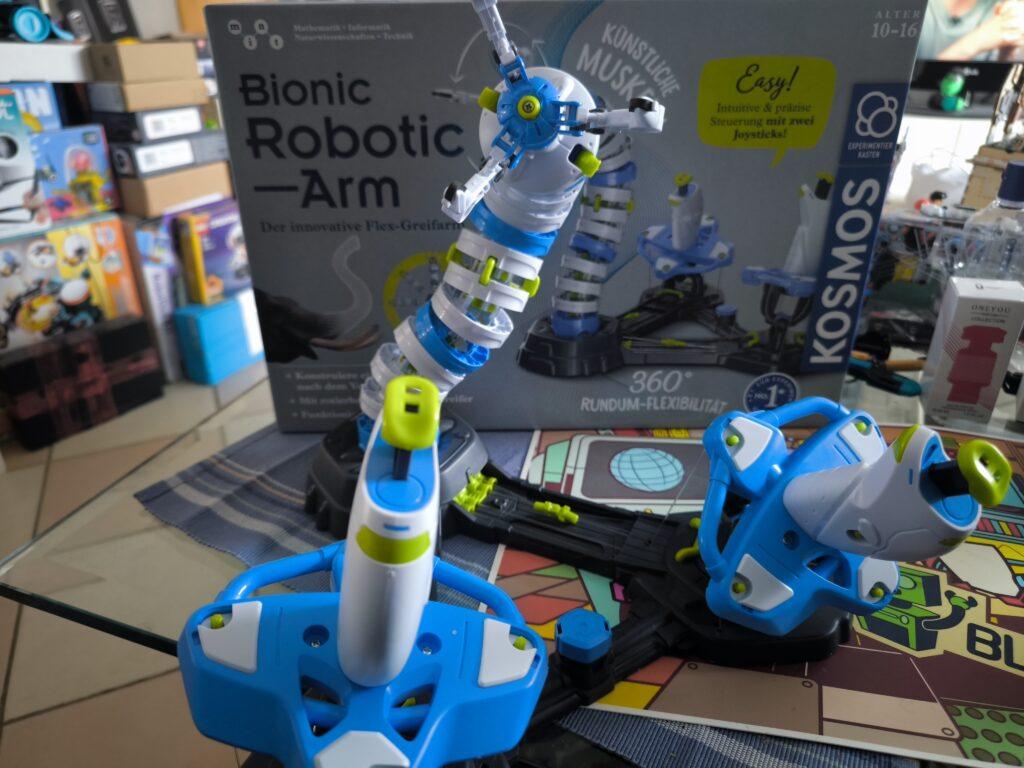
Zielgruppe
Empfohlen wird das Set für Kinder ab etwa zehn Jahren, wobei jüngere Baufans durchaus Unterstützung gebrauchen können. Auch für Modellbau-Fans und Sammler ist das System durch seine mechanische Funktionsweise interessant.
Fazit
Der Kosmos Bionic Robotic Arm ist ein Experimentierbaukasten mit spannendem mechanischem Konzept. Sein bionisch inspiriertes Zugseilsystem hebt sich deutlich von anderen Roboterarmen ab und bietet wertvolle technische Einblicke.
Besonders zeichnet sich der Bausatz durch seinen Lerneffekt, die robuste Bauweise und die geschmeidigen Bewegungen des fertigen Arms aus. Die hohen Anforderungen an Präzision und Geduld beim Aufbau sind für viele Nutzer eine echte Herausfoderung, können aber gerade bei Kindern zu Frust führen.
Insgesamt handelt es sich um ein solides Lernspielzeug für Bastlerinnen und Bastler, das mit Herausforderungen, aber auch mit einem faszinierenden Arbeitsprinzip belohnt. Wer Freude an Technik, Robotern, Bionik und Mechanik hat, wird viel Spaß am Kosmos Bionic Robotic Arm haben.
RoboCup 2027: Nürnberg als Zentrum der Robotik bei den RoboCup-Weltmeisterschaften in Deutschland
Die RoboCup Weltmeisterschaft 2027 findet im Juni in Deutschland statt: Mit Nürnberg wurde zum Abschluss des RoboCup 2025 in Brasilien offiziell der Austragungsort für den weltweit renommiertesten Wettbewerb für intelligente Robotik bekanntgegeben. Damit holt Deutschland die internationale Robotik-Elite erstmals seit 2016 wieder ins eigene Land – und setzt ein starkes Zeichen für seine technologische Zukunftsfähigkeit.
Der RoboCup gilt als globaler Leuchtturm für Forschung und Entwicklung in Robotik und Künstlicher Intelligenz (KI). Jährlich messen sich hier die besten Teams aus Universitäten, Hochschulen für Angewandte Wissenschaften und Schulen in realitätsnahen Szenarien – von Fußball über Haushaltsrobotik bis zu Rettungs- und Industrieanwendungen. Deutschland gehört seit Jahren zur Weltspitze und ist nun wieder Gastgeber dieses einzigartigen Innovationswettbewerbs.
Strategische Bedeutung für den Standort Deutschland
„Zentral für den Erfolg der Vergabe des RoboCup 2027 nach Nürnberg war die Unterstützung des Bundesministeriums für Forschung, Technologie und Raumfahrt, des Freistaats Bayern, der Stadt Nürnberg, des Robotics Institute Germany, der NEURA Robotics, der AFAG Messen und Ausstellungen GmbH, der Hans und Ria Messer Stiftung und nicht zuletzt des deutschen RoboCup-Komitees. Mit der Vergabe wird Deutschlands Rolle als international sichtbarer Impulsgeber für KI-basierte Robotik gestärkt“, erklärt Prof. Dr. Oskar von Stryk, Technische Universität Darmstadt, Co-Chair des RoboCup 2027. „Gerade vor dem Hintergrund des Fachkräftemangels und der demografischen Entwicklung brauchen wir innovative Technologien, die körperlich fordernde Arbeit intelligent unterstützen und zugleich dazu beitragen, Menschen in jeder Lebenslage ein selbstbestimmtes und unabhängiges Leben zu ermöglichen.“, ergänzt Dr. Maike Paetzel-Prüsmann, Johannes Gutenberg-Universität Mainz, Co-Chair des RoboCup 2027.
KI-basierte Robotik – sogenannte verkörperte Künstliche Intelligenz – ist entscheidend, um auch künftig Wohlstand, Wettbewerbsfähigkeit und Versorgungssicherheit zu garantieren. Der RoboCup beschleunigt die Entwicklung solcher Systeme, indem er Forschenden und Nachwuchstalenten eine reale Test- und Vergleichsplattform bietet – und Begeisterung für Technik und Innovation weckt.
Nachwuchsförderung und Gründergeist
Die RoboCup-Weltmeisterschaft ist mehr als ein Technologiewettbewerb – sie ist Talentschmiede, Bildungsplattform und Sprungbrett für Start-ups. In den Junior-Ligen sammeln Schülerinnen und Schüler erste Erfahrungen mit Informatik und Mechatronik, in den Major-Ligen entwickeln Studierende und Promovierende komplexe autonome Systeme auf höchstem Niveau. Viele starten danach erfolgreiche Karrieren in Unternehmen oder gründen eigene technologiegetriebene Start-ups.
„Der RoboCup verbindet Hightech mit Bildung, Wissenschaft mit Praxis, internationalen Austausch mit regionaler Innovationskraft“, so Prof. Dr. Stefan May, Technische Hochschule Nürnberg Georg Simon Ohm, Local Chair des RoboCup 2027. „Nürnberg bietet dafür das ideale Umfeld – zentral gelegen, technologisch und wirtschaftlich stark vernetzt und mit einer lebendigen Wissenschafts- und Gründerszene.“
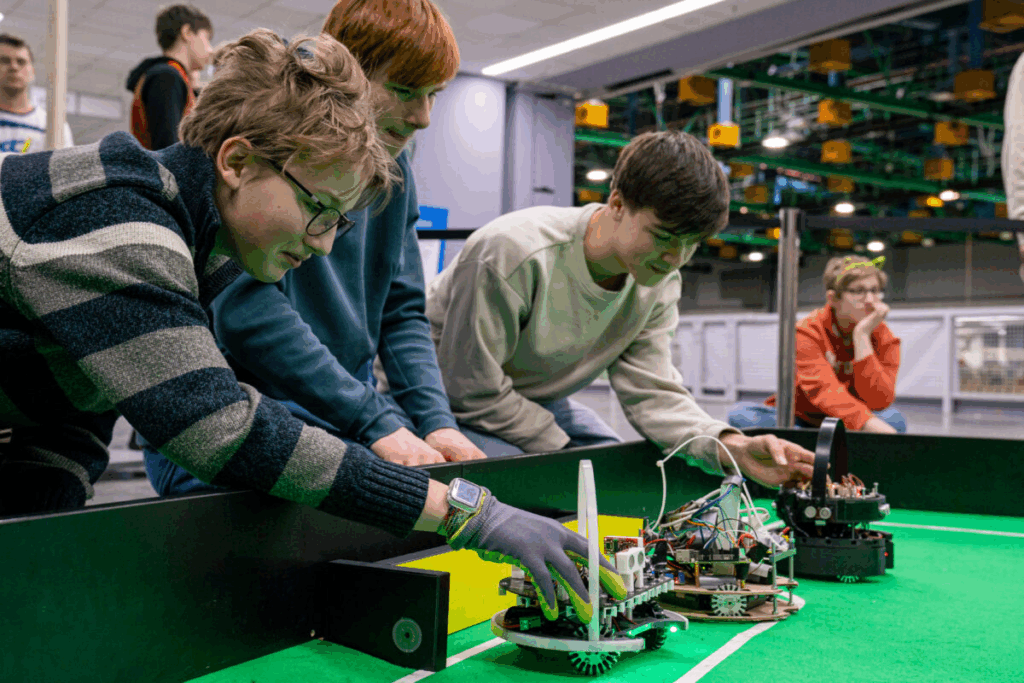
2027: Ein Meilenstein für Deutschland im Technologie-Wettlauf
Mit Blick auf den internationalen Wettlauf um technologische Souveränität setzt die RoboCup-Weltmeisterschaft 2027 ein wichtiges Signal. Deutschland braucht hochqualifizierte Köpfe und starke Innovationsökosysteme, um langfristig unabhängig und wettbewerbsfähig zu bleiben. Der RoboCup leistet dazu einen entscheidenden Beitrag.
Dorothee Bär, Bundesministerin für Forschung, Technologie und Raumfahrt: „In der Verbindung von KI und Robotik steckt ein riesiges Potential für Deutschland und Europa. Deshalb haben wir uns in der Bundesregierung die Förderung dieser Schlüsseltechnologien in der Hightech Agenda Deutschland zum Ziel gesetzt. Mit dem bereits vom Bundesforschungsministerium geförderten Robotics Institute Germany und dessen Verbindung zum RoboCup unterstützen wir gezielt Spitzenforschung und Talente für die KI-basierte Robotik. Bereits 2024 und 2025 haben wir die RoboCup German Open daher auch finanziell gefördert. Und wir haben auch die Bewerbung für die Weltmeisterschaft unterstützt. Ich freue mich sehr, dass wir den RoboCup 2027 in Deutschland willkommen heißen.“
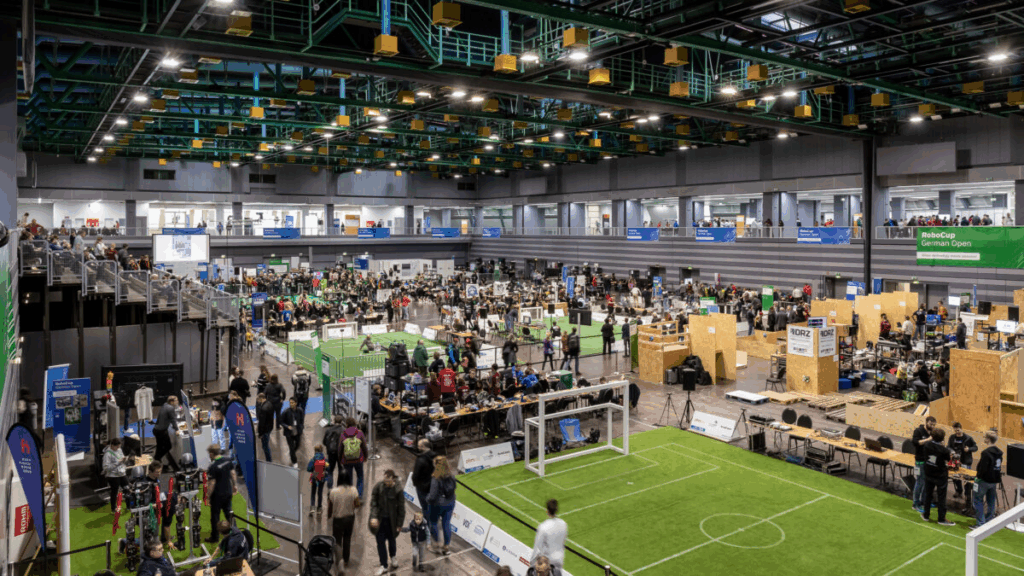
Dr. Markus Söder, Ministerpräsident des Freistaates Bayern: „Bayern ist bei Kl und Robotik einer der führenden Standorte Europas. Mit unserer Hightech Agenda investieren wir insgesamt sechs Milliarden Euro in Wissenschaft und Forschung. Damit soll etwa im ganzen Land ein einzigartiges Ökosystem für Künstliche Intelligenz wachsen. Das „Munich Center for Machine Learning“ und das „Munich Institute of Robotics and Machine Intelligence“ stehen für Künstliche Intelligenz von Weltrang – und in Nürnberg gründen wir mit der Technischen Universität UTN die erste rein auf Kl spezialisierte Universität in Deutschland. Die Staatsregierung freut sich auf die Austragung der RoboCup-Weltmeisterschaft 2027 in Nürnberg. Wir spielen in der Hightech-Champions-League – daher ist Bayern der perfekte Ort für den RoboCup!“.
Dr. Fabian Mehring, Bayerischer Staatsminister für Digitales: „Nürnberg ist unser bayerischer Leuchtturm für Robotik und Künstliche Intelligenz – mit der ersten eigenständigen KI-Universität Deutschlands und zahlreichen innovativen Forschungseinrichtungen. Die Stadt verfügt über eine starke Infrastruktur für internationale Veranstaltungen und engagiert sich aktiv für den wissenschaftlichen Nachwuchs. Ziel ist es, junge Talente zu begeistern und globale Netzwerke in Robotik und KI zu stärken. Ich freue mich darauf, die Teilnehmenden in Nürnberg willkommen zu heißen – für eine innovative Zukunft, die wir proaktiv und gemeinsam gestalten wollen.“
Prof. Dr. Tamim Asfour, Karlsruhe Institut für Technologie, Sprecher des Robotics Institute Germany (RIG): „Das RIG hat die Bewerbung Deutschlands für den RoboCup 2027 mit großem Nachdruck unterstützt. Als bundesweite Plattform führender Robotik- und KI-Institutionen – gefördert vom Bundesministerium für Forschung, Technologie und Raumfahrt – verbindet RIG Spitzenforschung, Talente und Wirtschaft, um bahnbrechende Innovationen voranzutreiben. Wettbewerbe wie der RoboCup sind starke Impulsgeber für Fortschritt und internationale Zusammenarbeit. Nach dem erfolgreichen Auftakt der German Robotics Conference gemeinsam mit den RoboCup German Open 2025 freuen wir uns darauf, die globale Robotik-Community in Deutschland für das größte Robotik- und KI-Event Europas in 2027 willkommen zu heißen.“
Prof. Dr. Angela Schoellig, TU München, Koordinatorin des Robotics Instituts Germany: „RoboCup und das Robotics Institute Germany teilen eine inspirierende Vision: Gemeinsam treiben wir bahnbrechende Innovationen in Robotik und Künstlicher Intelligenz voran – für eine nachhaltige Zukunft in Deutschland und weltweit. Mit der RoboCup-Weltmeisterschaft 2027 holen wir die klügsten jungen Köpfe aus aller Welt nach Deutschland. Wir sind begeistert, dieses einzigartige Event als Robotics Institute Germany mitzugestalten und zu unterstützen!“
David Reger, CEO und Gründer NEURA Robotics: „Wir entwickeln kognitive Roboter, die sehen, hören, fühlen und ganz natürlich mit Menschen und ihrer Umgebung interagieren. Beim Besuch der RoboCup German Open 2025 hat mich beeindruckt, wie Menschen verschiedener Generationen gemeinsam Roboter intelligente Aufgaben lösen lassen. Als größte Volkswirtschaft Europas ist Deutschland führend in den Bereichen Robotik und Automatisierung – mit einer starken Forschungsbasis. Damit ist hier der richtige Ort, um den RoboCup 2027 auszurichten.“
Über den RoboCup und das deutsche RoboCup-Komitee
Der 1997 gegründete RoboCup ist mit Teams aus mehr als 50 Nationen der weltweit älteste und größte Wettbewerb für intelligente Robotersysteme. Ziel ist es, technologische Entwicklungen in Robotik und KI durch reale Anwendungsszenarien voranzutreiben. Die Teilnehmenden entwickeln intelligente kollaborative robotische Systeme, die komplexe Aufgaben eigenständig bewältigen – unter Wettbewerbsbedingungen, die Innovation, Kreativität und Teamarbeit fordern.
Deutsche Wissenschaftlerinnen und Wissenschaftler haben die Entwicklung des RoboCups wesentlich mitgeprägt. Die deutschen Teams sind im RoboCup-Komitee Deutschland organisiert und haben die Bewerbung mit großem Engagement unterstützt und werden auch bei der Ausrichtung der Weltmeisterschaft eine tragende Rolle spielen. Sämtliche Mitglieder übernehmen zentrale Aufgaben in der Organisation und bringen ihre Expertise aktiv ein. Die Vorfreude ist spürbar – nicht nur das deutsche RoboCup-Komitee, sondern der gesamte RoboCup Deutschland blickt mit großer Erwartung darauf, die internationale RoboCup-Gemeinschaft 2027 wieder in Deutschland begrüßen zu dürfen.
Wir vom Robots-Blog freuen uns auf dieses Event und werden versuchen vor Ort dabei zu sein!
Unitree Introducing | Unitree R1 Intelligent Companion Price from $5900
Alexander Zorn vom Fraunhofer IAIS stellt KI gesteuerten Roboterarm im Robots-Blog Interview vor
Robots-Blog besucht Vention auf der automatica 2025. Andrea Alboni im Gespräch mit Sebastian Trella
Robots-Blog trifft Alexander Mühlens und igus ersten humanoiden Roboter „Iggy Rob“ auf der automatica
Wo Ideen tanzen und Technik begeistert – Riesige Ballerina tanzt auf der Maker Faire Hannover
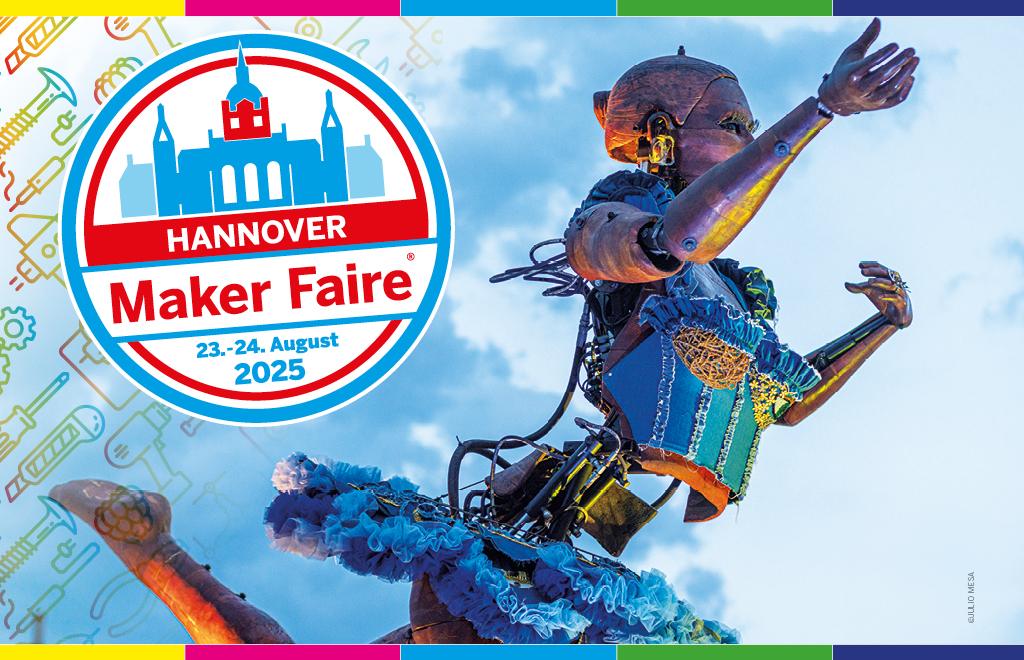
Hannover, 30. Juni 2025 – Technik, Kunst und gesellschaftliche Botschaft verschmelzen in einem außergewöhnlichen Projekt der spanischen Theatergruppe Antigua i Barbuda auf dem DIY-Event Maker Faire Hannover, das am 23. und 24. August im HCC stattfindet. Mit „La Danseuse“, einer über fünf Meter hohen mechanischen Ballerina, setzen die Künstlerinnen ein kraftvolles Zeichen für weibliches Empowerment – umgesetzt mit beeindruckender Ingenieurskunst.
Das größte Maker-Treffen im deutschsprachigen Raum verwandelt das Hannover Congress Centrum (HCC) bereits zum elften Mal in ein kreatives Ideenlabor. Eine der Hauptattraktionen in diesem Jahr: die faszinierende Performance von „La Danseuse“, die technische Feinheit und anmutige Bewegung auf eindrucksvolle Weise vereint.
„Diese einzigartige Theatererfahrung aus Objekten in Bewegung symbolisiert Freiheit und weibliche Stärke”, erklärt die Theatergruppe, die ihre monumentale Maschinenfrau erstmals in Deutschland präsentiert.
Sicher ist: „La Danseuse“ wird mit ihrer Präsenz und Ausdruckskraft für Staunen sorgen – und zeigen, wie Maschinen nicht nur funktionieren, sondern auch berühren können. „Passend zu unserem Show Act und der Projektvielfalt unserer Aussteller steht die diesjährige Maker Faire unter dem Motto ‚Wo Ideen tanzen und Technik begeistert‘, erklärt Daniel Rohlfing, Leiter Events & Sales Maker Faire Deutschland. „Das macht neugierig und trifft den Kern der Veranstaltung.“
Seit ihrer Premiere im Jahr 2013 hat die Maker Faire Hannover über 140.000 Besucherinnen und Besucher begeistert. Mit interaktiven Stationen, Workshops und Präsentationen bietet sie den idealen Rahmen für ein Projekt wie „La Danseuse“. Neben der Maschinenperformance erwarten die Gäste an rund 230 Ständen zahlreiche weitere kreative Ideen von Makern, Erfinderinnen und Forschern, die zum Mitmachen und Staunen einladen.
Tickets für die Maker Faire Hannover sind im Onlineshop oder an der Tageskasse (bargeldlos) erhältlich. Der Eintritt für Erwachsene kostet 24 Euro, ermäßigt 19 Euro. Kinder unter 10 Jahren können kostenlos dabei sein. Die Veranstaltung öffnet am Samstag von 10 bis 18 Uhr und am Sonntag von 10 bis 17 Uhr. Weitere Infos unter: maker-faire.de
Über die Maker Faire Hannover:
Seit 2013 begeistert die Maker Faire Hannover als Plattform für Inspiration, Kreativität und Innovation Teilnehmer aller Altersgruppen. Die Veranstaltung bringt Technik, Handwerk und Kunst zusammen und hat sich zu einem festen Termin im Kalender der internationalen Maker-Szene etabliert.
Volker Spanier präsentiert neuen Epson 6-Achs-Roboter Cobot AX6 im Robots-Blog Interview auf automatica 2025
Spielerische Robotik-Ausbildung: igus Low-Cost-Automation bewährt sich im Schulalltag
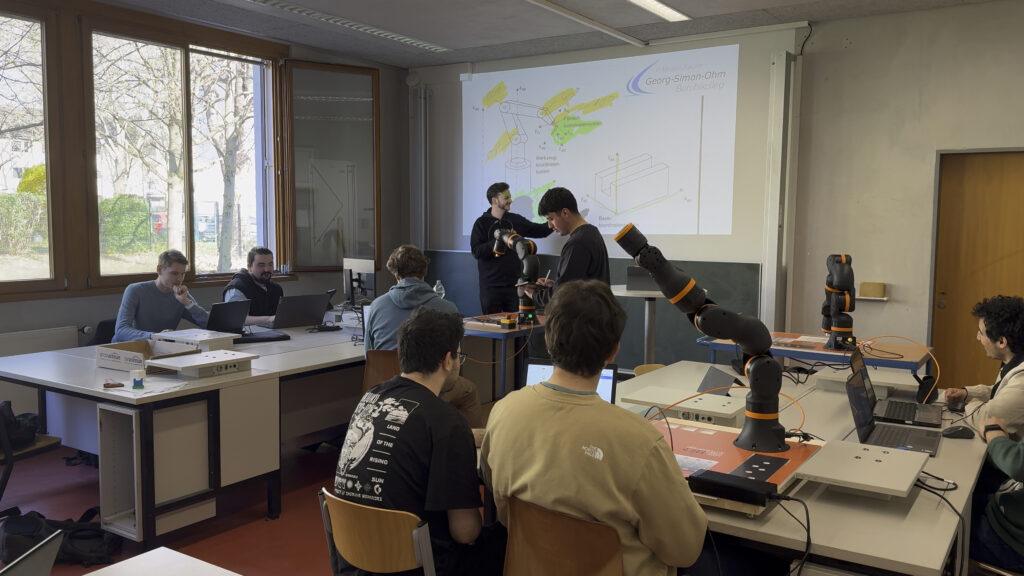
Georg-Simon-Ohm-Berufskolleg setzt auf ReBeL Cobots und Education Kits von igus, um Schülern einen einfachen Einstieg in die Roboter-Programmierung zu ermöglichen
Köln, 17. Juni 2025 – Junge Menschen für Technik begeistern: Dieses Ziel verfolgt der Kunststoffspezialist und Robotikhersteller igus mit seinen Bildungsangeboten speziell für Schulen, Hochschulen und Universitäten. Dazu zählt auch das ReBeL Education Kit: Ein Lernpaket, das Schülern und Studierenden den spielerischen Einstieg in die Robotik mithilfe des ReBeL Cobots ermöglichen soll. Zum Einsatz kommen die Education Kits unter anderem am Georg-Simon-Ohm-Berufskolleg in Köln. So bekommen die Schüler die Möglichkeit, erste Programmierkenntnisse zu erwerben und praxisnahe Anwendungen zu erproben.
Von Elektrotechnik über Datenbankwissen bis hin zur Softwareentwicklung: Die Ausbildung zum Informationstechnischen Assistenten am Georg-Simon-Ohm-Berufskolleg in Köln umfasst ein vielseitiges Lehrprogramm. Dazu gehört auch das Programmieren von Robotern, um den Schülern besondere Qualifikationen in der Automatisierungstechnik zu vermitteln. „Für unsere Robotik-Klasse kamen bisher humanoide Robotiksysteme zum Einsatz, die jedoch mit der Zeit störungsanfällig geworden sind“, erklärt Kevin Meyer, Lehrer für Elektrotechnik und Robotik am Georg-Simon-Ohm-Berufskolleg. „Daher brauchten wir Ersatz für die alten Systeme und haben uns gezielt auf die Suche nach Roboterarmen gemacht, die einfach zu bedienen sind und realitätsnahe Anwendungsszenarien ermöglichen.“ Fündig wurde das Berufskolleg schließlich beim Kölner Kunststoffspezialisten igus.
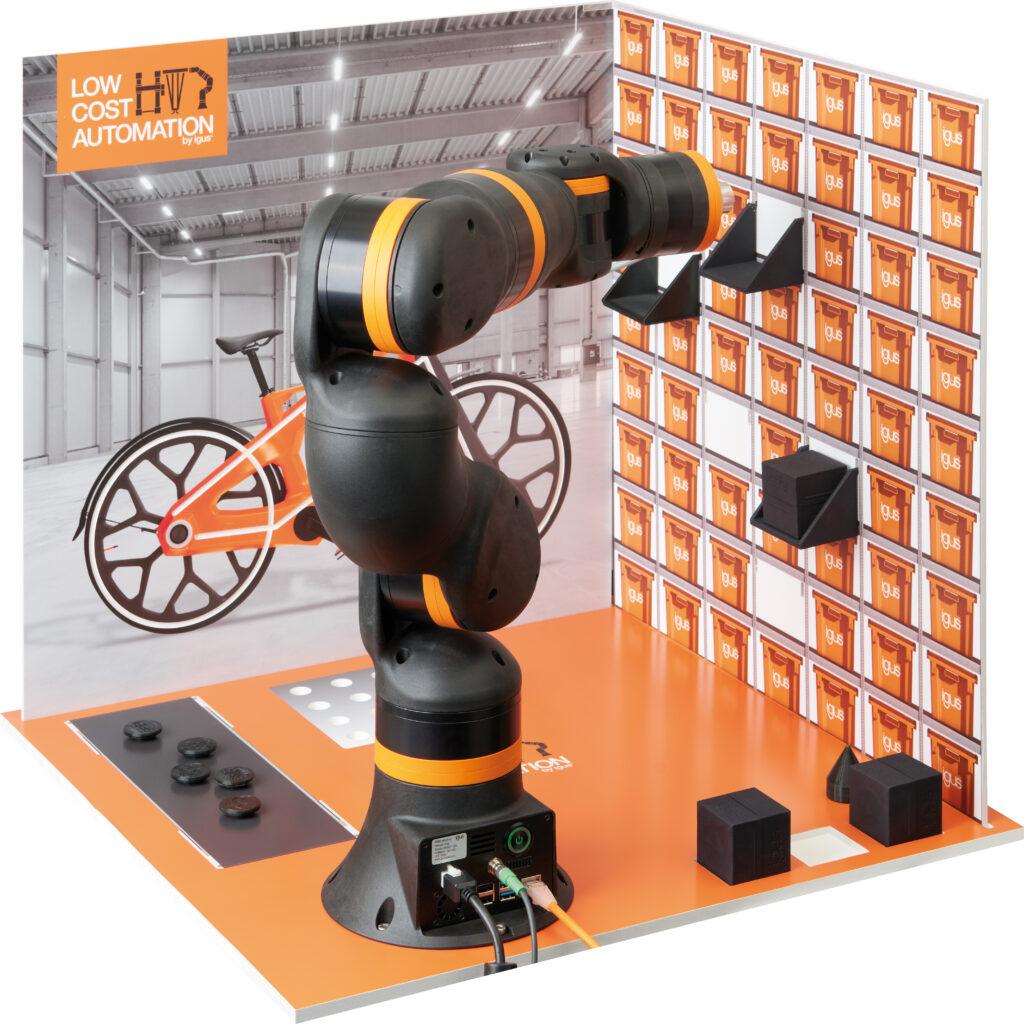
Programmieren lernen mit realitätsnahen Anwendungsbeispielen
„igus war uns bereits für seine Energieketten bekannt, doch bei unserer Suche sind wir dann auch auf das Low-Cost-Automation-Angebot gestoßen und haben gleich einen Beratungstermin vor Ort ausgemacht“, erzählt Kevin Meyer. Auf der 400 Quadratmeter großen Customer Test Area können Kunden zahlreiche Automationslösungen aus der Praxis in Aktion sehen und gemeinsam mit den Robotik-Experten von igus die Machbarkeit ihrer geplanten Anwendung testen. Die Wahl fiel schließlich auf zehn ReBeL Cobots mit sechs Achsen inklusive Education Kits. „Roboter gibt es auf dem Markt zwar viele, aber die Alternativen waren für unsere Zwecke entweder zu klein oder zu teuer. Zudem war für uns auch eine leichte Bedienbarkeit wichtig.“ Der ReBeL Cobot mit einem Gewicht von nur 8,2 Kilogramm, einer Traglast von zwei Kilogramm und einer Reichweite von 664 Millimetern ist in der vollausgestatteten Plug-and-Play-Variante bereits für 4.970 Euro erhältlich. Im Education Kit enthalten sind über 100 Stunden Lernmaterial und Projektplatten, die auf eine Arbeitsfläche montiert werden. Anhand derer lassen sich unterschiedliche Szenarien mit Realitätsbezug programmieren: ob Behälter in ein Hochregal sortieren, Bauteile eines Fahrrads vom Förderband nehmen und an der entsprechenden Stelle einsetzen oder die Qualitätskontrolle am Fahrrad. Die kostenlose und lizenzfreie igus Robot Control Software ermöglicht zudem eine einfache Bedienbarkeit und erleichtert den Einstieg in die Roboterprogrammierung.
Lernende gezielt auf die moderne Arbeitswelt vorbereiten
Die ReBeL Cobots und Education Kits sind inzwischen seit einem Jahr in vier Robotik-Klassen des Berufskollegs im Einsatz. „Die meisten Schüler arbeiten sehr gerne mit den Robotern. Die Bedienung war am Anfang für manche noch eine Herausforderung, aber am Ende haben es alle geschafft“, erzählt Kevin Meyer. Die Software sei visuell sehr anschaulich und ermögliche den Schülern, schnell kleine Fortschritte zu machen. Alexander Mühlens, Leiter Geschäftsbereich Low-Cost-Automation bei igus betont: „Uns liegt die Förderung des Roboternachwuchses sehr am Herzen, daher freuen uns solche Projekte immer besonders. Mit unserem breiten Bildungsangebot möchten wir Schulen, Hochschulen und Universitäten dabei unterstützen, theoretisches Wissen praxisnah zu vermitteln und Lernende gezielt auf die moderne Arbeitswelt vorzubereiten.“
Mehr Informationen zum Robotik-Bildungsangebot von igus finden Sie hier:
